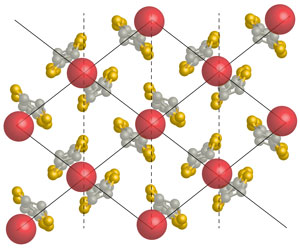Nov. 22, 2019 Research Highlight Physics / Astronomy
Frustration explains differences in superconductivity in molecular conductors and cuprates
Calculations reveal important insights into how superconductivity arises in a molecular conductor
 Figure 1: The molecular arrangement of the bis(ethylenedithio)tetrathiafulvalene (BEDT-TTF) layer in the molecular conductor investigated in this study (gold spheres: sulfur; silver spheres: carbon; red spheres: holes between two molecules). This arrangement gives rise to multiple lowest energy states due to geometrical frustration. Reprinted with permission of AAAS from Ref. 2. © Kawasugi et al., some rights reserved; exclusive licensee American Association for the Advancement of Science. Distributed under a Creative Commons Attribution NonCommercial License 4.0
Figure 1: The molecular arrangement of the bis(ethylenedithio)tetrathiafulvalene (BEDT-TTF) layer in the molecular conductor investigated in this study (gold spheres: sulfur; silver spheres: carbon; red spheres: holes between two molecules). This arrangement gives rise to multiple lowest energy states due to geometrical frustration. Reprinted with permission of AAAS from Ref. 2. © Kawasugi et al., some rights reserved; exclusive licensee American Association for the Advancement of Science. Distributed under a Creative Commons Attribution NonCommercial License 4.0
A significant difference between the superconductivity in two important unconventional superconducting systems has been found by three theoretical physicists at RIKEN1. This finding provides physicists with valuable clues for gaining a better understanding of how superconductivity works in these systems.
The resistance-less flow of electricity, or superconductivity, can be broadly divided into two categories: conventional and unconventional. The mechanism for conventional superconductivity has been known for over 60 years, whereas the mechanism for unconventional superconductivity has yet to be fully unraveled. Establishing how superconductivity operates in unconventional superconductors would be a major step toward achieving the long desired goal of realizing superconductivity at room temperature.
Unconventional superconductivity occurs in various materials. The most well known are copper oxides called cuprates, which superconduct at relatively high temperatures. A few molecular conductors—organic compounds that conduct electricity—also exhibit unconventional superconductivity. Physicists have been discussing whether the superconductivity in cuprates and molecular conductors originates from similar mechanisms.
“The superconductivity mechanisms in cuprates and molecular conductors are under debate,” notes chief scientist Seiji Yunoki. “The two systems have a lot of similarities, but also some differences.”
Now, Yunoki and Hiroshi Watanabe of the RIKEN Computational Condensed Matter Physics Laboratory and Hitoshi Seo of the RIKEN Condensed Matter Theory Laboratory have theoretically calculated the electronic properties of a molecular conductor based on the sulfur-containing organic compound bis(ethylenedithio)tetrathiafulvalene (BEDT-TTF) (Fig. 1).
In particular, they investigated how adding electrons to it affects its electronic properties. The trio also explored what happens when electrons are removed, which is equivalent to adding ‘holes’—gaps in the molecular structure that lack electrons. They discovered that there are two different types of superconductivity that have different symmetries—one is favored when electrons are added, while the other is favored when holes are added.
This theoretical prediction has recently been broadly confirmed by an experimental study conducted by a team of experimentalists at RIKEN.
This differs from what happens in cuprates. The researchers attribute this difference to the fact that the crystal structure of the molecular conductor is such that various states are energetically competing. As a result, they switch between each other when there are subtle changes in parameters. This phenomenon is known as geometrical frustration.
“Our simulation indicates that the superconductivity mechanism in our system is different in the strictest sense because it has geometrical frustration, whereas there is no frustration in cuprates,” says Watanabe.
The team now intends to investigate what happens to their molecular conductor at higher temperatures.
Related contents
- Light pulses provide a new route to enhance superconductivity
- Electrons in iron-based superconductors can pair up in two different ways
- Electrons that stick together, superconduct together
Reference
- 1. Watanabe, H., Seo, H. & Yunoki, S. Mechanism of superconductivity and electron-hole doping asymmetry in κ-type molecular conductors. Nature Communications 10, 3167 (2019) doi: 10.1038/s41467-019-11022-1
- 2. Kawasugi, Y., Seki, K., Tajima, S., Pu, J., Takenobu, T., Yunoki, S., Yamamoto, H. M. & Kato, R. Two-dimensional ground-state mapping of a Mott-Hubbard system in a flexible field-effect device. Science Advances 5, eaav7282 (2019). doi: 10.1126/sciadv.aav7282
